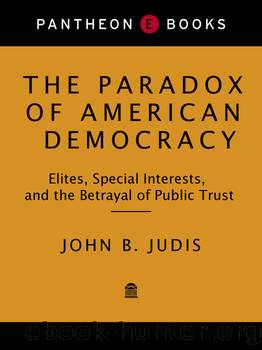The Paradox of American Democracy by John B. Judis

Author:John B. Judis [Judis, John B.]
Language: eng
Format: epub
ISBN: 978-0-8041-5062-0
Publisher: Knopf Doubleday Publishing Group
Published: 2013-05-22T00:00:00+00:00
The early conservative movement was limited in its popular appeal. As Goldwater discovered in 1964, most Americans didnât want to get rid of Social Security or go to the brink of war with the Soviet Union. Over the next sixteen years, however, America changed in ways that made the conservative message more palatable. School integration drove white Southerners into the Republican Partyâthe Deep South was the only region Goldwater won in 1964. Busing, affirmative action, and rising welfare costs, coming in the wake of the ghetto riots, split the the New Deal coalition in the North and made many white ethnic Democrats receptive to conservative appeals. Conservatives, who had opposed the civil rights acts out of either racism or support for stateâs rights, suddenly found their political base immeasurably widened. Northern whites also became more receptive to conservativesâ harsh message on welfare and crime.
The U.S. defeat in Vietnam, coupled with advances in Soviet influence in Africa and Central America, made the conservativesâ militant message on Communism far more credible, while the economic downturn that began in the late 1960s lent credence to conservative arguments for free-market capitalism. And the court rulings on abortion and school prayer, along with the continued spread of the counterculture and the womenâs movement, produced an entirely new constituency for conservatism.
Conservative politicians and intellectuals also adapted their own message to take advantage of these opportunities. In his 1966 California gubernatorial campaign, Ronald Reagan exploited the historic distrust of government and of elites to rally voters to his side. He reminded voters that he had once been a union leader, while directing his fire at students, whom he described as âelitistsâ disrupting the universities that middle-class taxpayers were financing. He didnât attack welfare capitalism itself, but attacked welfare cheaters (invariably black or Mexican-American in votersâ minds). He didnât openly favor segregation, but he opposed a fair housing measure on the ballot. Because Reagan was running for governor rather than senator, he didnât have to take positions on the old conservative bugaboos of Social Security or nuclear war.
In the early 1970s, a group of young conservatives, who became identified as âthe new right,â tried to take advantage of the backlash against the civil rights movement and the counterculture. Instead of railing against budget deficits, they focused on the âsocialâ issues that had emerged during the sixties, including abortion, busing and racial integration, drugs, school prayer, and gun control. Their motives were tactical: they recognized the political limitations of the older conservative movement and wanted to create a politics that could unite business conservatives with working-class Democrats disillusioned by the civil rights movement, antiwar protests, and the counterculture of the sixties.
Richard Viguerie, the son of a Texas petrochemical executive, came to New York from Texas in 1963 to become executive secretary of the Young Americans for Freedom (YAF). He became expert in using direct mail to finance campaigns. In 1968 he worked as a fund-raiser for George Wallace and from 1973 to 1976 raised money for Wallaceâs American Independent Party through the mailing lists he created.
Download
This site does not store any files on its server. We only index and link to content provided by other sites. Please contact the content providers to delete copyright contents if any and email us, we'll remove relevant links or contents immediately.
The Secret History by Donna Tartt(16762)
The Social Justice Warrior Handbook by Lisa De Pasquale(11517)
Thirteen Reasons Why by Jay Asher(7856)
This Is How You Lose Her by Junot Diaz(5845)
Weapons of Math Destruction by Cathy O'Neil(5094)
Zero to One by Peter Thiel(4885)
The Myth of the Strong Leader by Archie Brown(4821)
Promise Me, Dad by Joe Biden(4493)
Beartown by Fredrik Backman(4489)
How Democracies Die by Steven Levitsky & Daniel Ziblatt(4465)
Stone's Rules by Roger Stone(4455)
The Fire Next Time by James Baldwin(4398)
100 Deadly Skills by Clint Emerson(4128)
A Higher Loyalty: Truth, Lies, and Leadership by James Comey(4073)
Rise and Kill First by Ronen Bergman(4062)
The David Icke Guide to the Global Conspiracy (and how to end it) by David Icke(3934)
The Farm by Tom Rob Smith(3908)
Secrecy World by Jake Bernstein(3828)
The Doomsday Machine by Daniel Ellsberg(3772)
